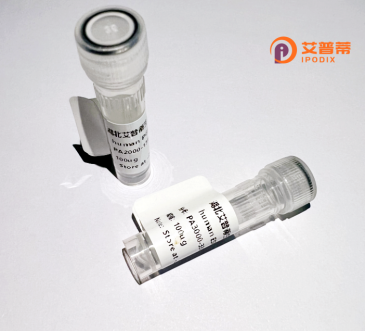
| 纯度 | >90%SDS-PAGE. |
| 种属 | Human |
| 靶点 | DDIT4L |
| Uniprot No | Q96D03 |
| 内毒素 | < 0.01EU/μg |
| 表达宿主 | E.coli |
| 表达区间 | 1-193aa |
| 氨基酸序列 | MVATGSLSSKNPASISELLDCGYHPESLLSDFDYWDYVVPEPNLNEVIFEESTCQNLVKMLENCLSKSKQTKLGCSKVLVPEKLTQRIAQDVLRLSSTEPCGLRGCVMHVNLEIENVCKKLDRIVCDSSVVPTFELTLVFKQENCSWTSFRDFFFSRGRFSSGFRRTLILSSGFRLVKKKLYSLIGTTVIEGS |
| 分子量 | 48.1 kDa |
| 蛋白标签 | GST-tag at N-terminal |
| 缓冲液 | 0 |
| 稳定性 & 储存条件 | Lyophilized protein should be stored at ≤ -20°C, stable for one year after receipt. Reconstituted protein solution can be stored at 2-8°C for 2-7 days. Aliquots of reconstituted samples are stable at ≤ -20°C for 3 months. |
| 复溶 | Always centrifuge tubes before opening.Do not mix by vortex or pipetting. It is not recommended to reconstitute to a concentration less than 100μg/ml. Dissolve the lyophilized protein in distilled water. Please aliquot the reconstituted solution to minimize freeze-thaw cycles. |
1. **"Hypoxia-induced regulation of DDIT4L in autophagy and apoptosis"**
- Authors: Liu Y, et al.
- 摘要:研究重组人DDIT4L蛋白在低氧条件下通过mTOR信号通路调控细胞自噬与凋亡的作用,揭示其与能量应激反应的关联。
2. **"Recombinant DDIT4L suppresses tumor growth via AMPK activation in hepatocellular carcinoma"**
- Authors: Zhang H, et al.
- 摘要:通过体外实验证实重组人DDIT4L蛋白可激活AMPK通路,抑制肝癌细胞增殖并促进代谢重编程,提出其潜在抑癌功能。
3. **"DDIT4L mediates endoplasmic reticulum stress response in cardiomyocytes"**
- Authors: Chen X, et al.
- 摘要:利用重组DDIT4L蛋白处理心肌细胞,揭示其在内质网应激中通过调控CHOP蛋白减轻氧化损伤的分子机制。
4. **"The role of recombinant DDIT4L in metabolic syndrome: Insights from transgenic models"**
- Authors: Kumar R, et al.
- 摘要:综述重组DDIT4L蛋白在脂质代谢与胰岛素抵抗中的作用,动物实验显示其过表达可改善肥胖相关代谢紊乱。
Recombinant human DDIT4L (DNA damage-inducible transcript 4-like) protein is a stress-responsive regulatory molecule involved in cellular adaptation to metabolic and hypoxic conditions. Encoded by the DDIT4L gene, this protein shares homology with DDIT4/REDD1. a key modulator of the mTOR (mammalian target of rapamycin) signaling pathway. Structurally, DDIT4L contains conserved domains that enable interaction with cellular stress sensors, though its precise molecular mechanism remains less characterized compared to DDIT4.
Expression of DDIT4L is induced under energy deprivation, hypoxia, or DNA damage, suggesting its role in balancing cell growth and survival during stress. It inhibits mTORC1 activity, a critical regulator of protein synthesis and autophagy, potentially through tuberous sclerosis complex (TSC) activation. Dysregulation of DDIT4L has been implicated in metabolic disorders, cancer progression, and ischemic diseases, where mTOR signaling imbalance contributes to pathological outcomes.
Recombinant DDIT4L is typically produced in bacterial or mammalian expression systems, enabling functional studies to elucidate its tissue-specific roles and therapeutic potential. Current research focuses on its dual context-dependent roles—either promoting apoptosis under severe stress or enhancing cell survival in mild stress—highlighting its complexity in stress adaptation. Its recombinant form serves as a valuable tool for exploring novel therapeutic strategies targeting mTOR-related pathways in oncology and metabolic diseases.
×